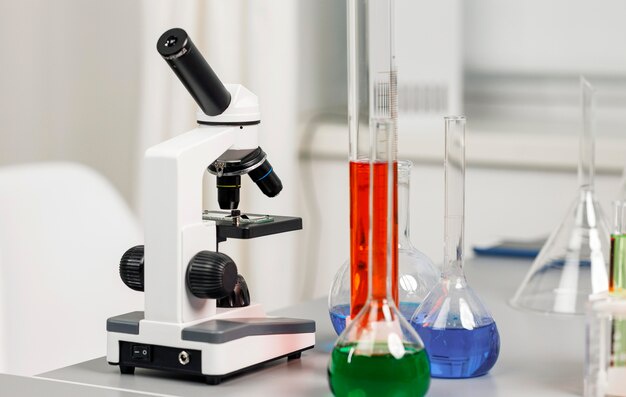Welcome to the fascinating world of laboratory science! Whether you're a student embarking on a journey of discovery or a seasoned researcher pushing the boundaries of knowledge, understanding the equipment used in the lab is essential. In this guide, we'll delve into the various types of science lab equipment, their functions, and why they're crucial for conducting experiments and analyses across diverse scientific disciplines.
1. Microscopes: Unlocking the Microscopic World
Microscopes are indispensable tools in scientific research, enabling scientists to observe objects and organisms at the microscopic level. There are several types of microscopes, including optical, electron, and fluorescence microscopes, each offering unique capabilities for examining specimens. Optical microscopes use visible light to magnify samples, while electron microscopes utilize electron beams for higher magnification and resolution. Fluorescence microscopes, on the other hand, employ fluorescence to visualize specific structures within cells or tissues. From studying cells and bacteria to analyzing minerals and materials, microscopes play a vital role in virtually every scientific field.
2. Centrifuges: Separating Substances with Precision
Centrifuges are instruments used to separate components of a mixture based on their density. By spinning samples at high speeds, centrifuges generate centrifugal force, causing heavier particles to settle at the bottom while lighter particles remain suspended or rise to the top. This process is invaluable for isolating cellular components, purifying DNA, and separating colloidal suspensions. With applications ranging from biochemistry and microbiology to clinical diagnostics and environmental science, centrifuges are indispensable tools for researchers seeking to analyze and manipulate biological and chemical samples.
3. Bunsen Burners: Heating Solutions with Precision
Bunsen burners are iconic pieces of laboratory equipment used for heating, sterilizing, and conducting experiments requiring controlled flame. Named after the German chemist Robert Bunsen, these burners produce a hot, blue flame by mixing flammable gas with air at adjustable ratios. By regulating the airflow and gas flow, scientists can fine-tune the intensity and temperature of the flame, making Bunsen burners versatile tools in chemistry, biology, and physics laboratories. Whether it's heating solutions, sterilizing equipment, or performing flame tests, Bunsen burners are indispensable for a wide range of scientific applications.
4. Pipettes: Dispensing Precise Volumes with Accuracy
Pipettes are essential tools for accurately measuring and transferring liquid volumes in the laboratory. Available in various designs, including micropipettes, graduated pipettes, and serological pipettes, these instruments enable scientists to dispense precise volumes of liquids with high accuracy and reproducibility. From preparing reagents and conducting experiments to performing biochemical assays and molecular biology techniques, pipettes are indispensable for maintaining consistency and precision in scientific workflows. With advancements such as electronic pipettes and automated liquid handling systems, researchers can streamline their processes and minimize errors in liquid handling tasks.
5. Incubators: Creating Optimal Growth Conditions
Incubators are specialized chambers designed to provide controlled environmental conditions for growing and maintaining biological cultures. These conditions typically include temperature, humidity, and sometimes carbon dioxide levels. By mimicking the natural habitat of cells, bacteria, and other microorganisms, incubators support their growth and proliferation for various research and clinical applications. Whether it's culturing cells for tissue engineering, incubating microbial cultures for microbiology studies, or growing plants in controlled environments for botanical research, incubators are essential for maintaining cell viability and ensuring reproducible results in biological experiments.
6. Spectrophotometers: Analyzing Light Absorption and Emission
Spectrophotometers are instruments used to measure the intensity of light absorption or emission by a substance as a function of wavelength. These devices are widely used in analytical chemistry, biochemistry, and molecular biology for quantitative analysis of substances such as nucleic acids, proteins, and small molecules. By measuring the absorbance or fluorescence of samples at specific wavelengths, spectrophotometers provide valuable insights into their concentration, purity, and molecular structure. With applications ranging from DNA quantification and enzyme kinetics to drug discovery and environmental monitoring, spectrophotometers are indispensable tools for scientists seeking to understand the chemical and biological properties of substances.
7. Autoclaves: Sterilizing Equipment and Media
Autoclaves are pressure chambers used to sterilize equipment, media, and laboratory waste by subjecting them to high-pressure steam at elevated temperatures. By effectively killing microorganisms and spores, autoclaves ensure the sterility of instruments and materials used in microbiology, biotechnology, and medical research. From sterilizing glassware and surgical instruments to preparing culture media and decontaminating biohazardous waste, autoclaves play a critical role in maintaining aseptic conditions and preventing contamination in the laboratory. With advanced features such as programmable cycles and automatic monitoring, modern autoclaves offer efficiency and convenience in sterilization processes.
8. pH Meters: Measuring Acidity and Alkalinity
pH meters are instruments used to measure the acidity or alkalinity of a solution by determining its hydrogen ion concentration. These devices consist of a probe that detects changes in hydrogen ion activity and converts them into pH readings. pH meters are essential tools in chemistry, biology, and environmental science for assessing the acidity or alkalinity of solutions, monitoring chemical reactions, and maintaining optimal conditions for biological processes. Whether it's testing the pH of soil for agriculture, analyzing the acidity of beverages in food industry quality control, or monitoring the pH of biological fluids in medical diagnostics, pH meters are indispensable for a wide range of scientific applications.
Conclusion
Science laboratory equipment encompasses a diverse array of instruments and apparatuses essential for conducting experiments, analyses, and research across various scientific disciplines. From microscopes and centrifuges to Bunsen burners and pH meters, each piece of equipment plays a unique role in advancing scientific knowledge and discovery. By understanding the functions and applications of these tools, scientists can optimize their experimental workflows, ensure accuracy and reproducibility, and ultimately contribute to the advancement of science and technology. Whether you're a novice exploring the wonders of the laboratory or a seasoned researcher pushing the boundaries of knowledge, mastering the use of laboratory equipment is key to success in scientific endeavors.


No comments yet